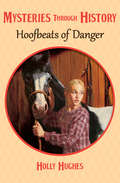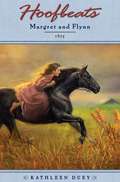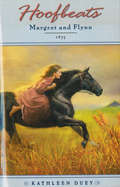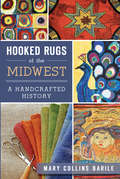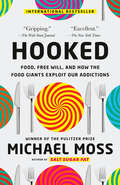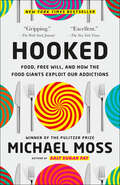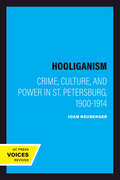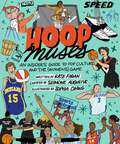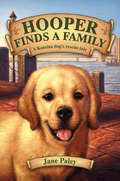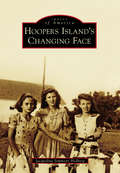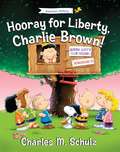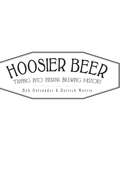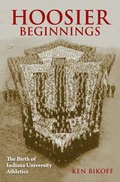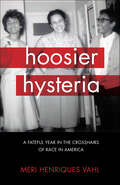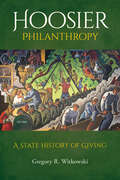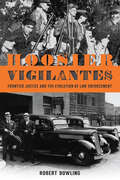- Table View
- List View
Hoof Beats: How Horses Shaped Human History
by William T. TaylorJourney to the ancient past with cutting-edge science and new data to discover how horses forever altered the course of human history. From the Rockies to the Himalayas, the bond between horses and humans has spanned across time and civilizations. In this archaeological journey, William T. Taylor explores how momentous events in the story of humans and horses helped create the world we live in today. Tracing the horse's origins and spread from the western Eurasian steppes to the invention of horse-drawn transportation and the explosive shift to mounted riding, Taylor offers a revolutionary new account of how horses altered the course of human history. Drawing on Indigenous perspectives, ancient DNA, and new research from Mongolia to the Great Plains and beyond, Taylor guides readers through the major discoveries that have placed the horse at the origins of globalization, trade, biological exchange, and social inequality. Hoof Beats transforms our understanding of both horses and humanity's ancient past and asks us to consider what our relationship with horses means for the future of humanity and the world around us.
Hoofbeats of Danger (Mysteries through History #2)
by Holly HughesSet in 1860 as the first wagon trains rumble into the American West, this adventure-filled novel centers on a frontier girl and the beloved pony she tries to save Born in the back of a covered wagon traveling west from Vermont, Annie Dawson dreams of someday seeing what&’s on the eastern side of the great Mississippi. For now, she&’ll have to be content living with her parents and younger brother in the Nebraska Territory at the Red Buttes Pony Express station run by her family. That is, until her favorite pony starts going wild, and Annie&’s friend—Pony Express rider Billy Cody—suspects that someone is poisoning her. But who&’d want to hurt gentle Magpie? Indian tribes stirring up trouble? Or the Butterfield Mail, the Pony Express rival that seems to feel threatened by the ponies&’ speed in delivering mail to California? The night before Magpie is scheduled to be put down, Annie steals out to see if her half-Shoshone friend Redbird Wilson can cure Magpie&’s mysterious ailment. But the pony just gets worse. Unsure whom she can trust, Annie must use her wits to find the culprit before Magpie dies and other horses meet the same fate. This ebook includes a historical afterword.
Hoofbeats: Lara at Athenry Castle
by Kathleen DueyNine-year-old Lara is the daughter of the r?-the leader of her cattle-raising clan. While she spends her days tending to the cattle, her heart lies with her beloved gray mare. When Lara goes to the highlands to set the cattle out to graze, she finds the mare in the process of a difficult birth. Lara vows to take care of the foal as a dying promise to the gray mare, and with the help of a childless milk-cow, she cares for the spindly-legged filly. But just when she is confident that the foal can survive, a rival clan captures them both, and throws Lara's life into turmoil. When the filly is eventually given to a titled baron in the castle town of Athenry, Lara, determined to stay with the horse no matter what, goes along. Together, she and her beloved horse face seemingly insurmountable challenges, but all along Lara keeps two things in mind. One day, she will manage to flee, and will set off in search of the family that she was taken from. And she will not leave without her silver mare. .
Hoofbeats: Margret and Flynn, 1875
by Kathleen DueyMargret and her sister Libby are living with Mrs. Fredriksen. Margret wants to stay forever, but not Libby. A sweeping tornado brings an injured horse. Margret lays claim to the horse, naming him Flynn, nursing him back to health, and teaching to ride. She has to convince Libby to stay so she can make Flynn hers.
Hoofbeats: Margret and Flynn, 1875
by Kathleen DueyThe year is 1875, and twelve-year-old orphan Margret and her sister, Libby, are living with the kind Mrs. Fredriksen in her sod house in rural Littleton, Colorado. Margret would be happy to stay forever, but she knows that Libby, with her basic distrust of anyone other than Margret, will have them moving soon enough. Then a tornado sweeps through, bringing with it an injured horse. Immediately Margret lays claim to the horse, naming him Flynn, nursing him back to health, and teaching herself to ride. Now more than ever, Margret yearns for some stability in her life. Somehow, she's got to find a way to convince Libby to stay so she can make Flynn hers. Powerfully written and historically accurate, this is a great addition to the series that's tailor-made for girls who love horses and historical fiction.
Hoofbeats: Silence and Lily, 1773
by Kathleen DueyTwelve-year-old Silence wants a chance to call Lily--a beautiful snow-white mare-- her own which her mother disapproves. Silence learns that someone has kidnapped Lily and begins to worry that if she doesn't do something drastic, she may lose Lily forever.
Hooked
by Stef Ann HolmDelicious tension, hilarious wit, and heated passion make USA TODAY bestselling author Stef Ann Holm's acclaimed Brides books the perfect place to spin dreams and reel in true romance. In the second book of the Brides for All Seasons series, a newspaper reporter reels in true romance and fiery passion.Using an alias, stunt reporter Matthew Gage arrives in Harmony, Montana, to uncover the cheating going on in the town's famous annual fly-fishing contest--not to tangle lines with a husband-hunting miss. But as soon as Meg Brooks gets stuck under his hotel bed, he's hooked on her high-spirited charm. Besides, he hopes she'll provide him with insider information--and a few kisses--while he snoops around. But innocent Meg believes Matthew is "Vernon Wilberforce," a polite carpet-sweeper salesman, the gentleman caller of her dreams. As the fishy scandal threatens to upset Harmony, Meg employs every lure in the book to land Matthew. But her heart will be broken by a man who isn't what he seems...unless they each learn the truth: The best prize in life is given, not won. It's love.
Hooked Rugs of the Midwest: A Handcrafted History
by Mary Collins BarileThe art of rug hooking, which consists of pulling dyed and cut wool fabric pieces through a backing, has typically been associated with New England, the South and Canada. Yet rugs from the American Midwest have contributed just as much to the development of the craft and its continuing popularity. The story of hooked rugs in the Midwest is a ragbag blending of romance, folklore, myth and common sense told through the colors of barns and sky, golden wheat, farm ponds, red clay, red brick, steel, glass and fountains. In this vividly illustrated history, Mary Collins Barile shakes out the dust from the Midwestern hooked rug with the vigor its unique blend of utility and imagination deserves.
Hooked: Food, Free Will, and How the Food Giants Exploit Our Addictions
by Michael MossFrom the #1 bestselling and Pulitzer Prize-winning author of Salt Sugar Fat, the troubling story of how food companies have exploited our most fundamental evolutionary instincts to get us hooked on processed foods.Everyone knows how hard it can be to maintain a healthy diet. But what if some of the decisions we make about what to eat are beyond our control? Is it possible that processed food is addictive, like drugs or alcohol? Motivated by these questions, Pulitzer Prize-winning investigative reporter Michael Moss began searching for answers, to find the true peril in our food. In Hooked, Moss explores the science of addiction and uncovers what the scientific and medical communities--as well as food manufacturers--already know, which is that food can, in some cases, be even more addictive than alcohol, cigarettes, or drugs. Our bodies are hard-wired for sweets, so food manufacturers have deployed fifty-six types of sugar to add to their products, creating in us the expectation that everything should be cloying; we've evolved to prefer convenient meals, so three-fourths of the calories we get from groceries come from ready-to-eat foods. Moss goes on to show how the processed food industry has not only tried to deny this troubling discovery, but exploit it to its advantage. For instance, in a response to recent dieting trends, food manufacturers have simply turned junk food into junk diets, filling grocery stores with "diet" foods that are hardly distinguishable from the products that got us into trouble in the first place. With more people unable to make dieting work for them, manufacturers are now claiming to add ingredients that can effortlessly cure our compulsive eating habits. A gripping account of the legal battles, insidious marketing campaigns, and cutting-edge food science that have brought us to our current public health crisis, Hooked lays out all that the food industry is doing to exploit and deepen our addictions, and shows us what we can do so that we can once again seize control.
Hooked: Food, Free Will, and How the Food Giants Exploit Our Addictions
by Michael MossFrom the #1 New York Times bestselling author of Salt Sugar Fat comes a powerful exposé of how the processed food industry exploits our evolutionary instincts, the emotions we associate with food, and legal loopholes in their pursuit of profit over public health. <P><P>Everyone knows how hard it can be to maintain a healthy diet. But what if some of the decisions we make about what to eat are beyond our control? Is it possible that food is addictive, like drugs or alcohol? And to what extent does the food industry know, or care, about these vulnerabilities? <P><P>In Hooked, Pulitzer Prize–winning investigative reporter Michael Moss sets out to answer these questions—and to find the true peril in our food. Moss uses the latest research on addiction to uncover what the scientific and medical communities—as well as food manufacturers—already know: that food, in some cases, is even more addictive than alcohol, cigarettes, and drugs. Our bodies are hardwired for sweets, so food giants have developed fifty-six types of sugar to add to their products, creating in us the expectation that everything should be cloying; we’ve evolved to prefer fast, convenient meals, hence our modern-day preference for ready-to-eat foods. <P><P>Moss goes on to show how the processed food industry—including major companies like Nestlé, Mars, and Kellogg’s—has tried not only to evade this troubling discovery about the addictiveness of food but to actually exploit it. For instance, in response to recent dieting trends, food manufacturers have simply turned junk food into junk diets, filling grocery stores with “diet” foods that are hardly distinguishable from the products that got us into trouble in the first place. As obesity rates continue to climb, manufacturers are now claiming to add ingredients that can effortlessly cure our compulsive eating habits. <P><P>A gripping account of the legal battles, insidious marketing campaigns, and cutting-edge food science that have brought us to our current public health crisis, Hooked lays out all that the food industry is doing to exploit and deepen our addictions, and shows us why what we eat has never mattered more. <P><P><b>A New York Times Bestseller</b>
Hooliganism: Crime, Culture, and Power in St. Petersburg, 1900-1914 (Studies on the History of Society and Culture #19)
by Joan NeubergerIn this pioneering analysis of diffuse underclass anger that simmers in many societies, Joan Neuberger takes us to the streets of St. Petersburg in 1900-1914 to show us how the phenomenon labeled hooliganism came to symbolize all that was wrong with the modern city: increasing hostility between classes, society's failure to "civilize" the poor, the desperation of the destitute, and the proliferation of violence in public spaces.
Hoop Muses: An Insider's Guide to Pop Culture and the (Women's) Game
by Kate Fagan Seimone Augustus&“In vibrant color and style, Hoops Muses tells the vital stories that celebrate the history and tradition of our game.&” —Sue Bird, WNBA legendHoops Muses is an homage to the game, bringing style and flair to all the details, moments, and people who have shaped the collective world of (women&’s) hoops.Hoops Muses will take us through time – literally. We begin in the future, in 2072, on the night of the WNBA&’s 75th Anniversary, as New York Liberty phenom Jacklyn Jones is paid a visit by one of basketball&’s long-ago (wink, wink) greats. This unlikely duo then goes on a sweeping, roundtrip adventure through basketball history, starting at the very beginning: Springfield, 1891. As the years pass, they learn the roots of the game (think: the first-ever collegiate game between Stanford and Cal, where men scaled the walls for a peek inside, or, the legend of Chicago&’s Club Store Co-Eds, the all-Black barnstorming squad of the 1930s). AND as the early 20th century morphs into modern times, they see the game grow, the milestones reached. On their journey, they learn about the teams and the women (along with a few men) who helped build the foundation on which The Future will be built: -Fort Shaw and the 1904 World Championship -Pat Summitt and the early years of the Lady Vols -Delta State, featuring Margaret Wade and Lusia Harris -Cheryl Miller and Hollywood&’s USC Trojans -UConn-Tennessee and the &“Sliding Doors&” moment that sparked their rivalry Plus, they have front-row seats to a whole lot of quirky, blissful fandom, including … The Movies That Should Have Been WNBA Jam The Moments The Shots To be a (women&’s) hooper is to be part of a long and proud tradition … but one not often celebrated in popular culture. Hoops Muses is here to change that.
Hoop Roots
by John Edgar WidemanWhile presenting a memoir of discovering basketball, novelist Wideman (U. of Massachusetts-Amherst) reveals much about the origins of black basketball in the US.
Hooper Finds a Family
by Jane PaleyHe's endearing. He's funny. He's a survivor. Here comes Hooper, one plucky, spunky dog whose warm spirit and goofy personality are irresistible. Hooper tells his own dramatic rescue tale after being left homeless in the wake of Hurricane Katrina and taking a daring trip from New Orleans to New York to meet his new family. He tells of the terrifying force of Katrina, his trials in the shelter, and being the new dog on the block in a city far from home. As Hooper struggles to find his place, he learns to overcome his fear of water and faces down feisty squirrels as well as the resident bully and top dog in his new neighborhood. In a moving tale of adventure and triumph based on a true story, meet this tenacious puppy who makes an incredible journey in search of home.
Hooper Finds a Family
by Jane PaleyHe's endearing.He's funny.He's a survivor.Here comes Hooper, one plucky, spunky dog whose warm spirit and goofy personality are irresistible. Hooper tells his own dramatic rescue tale after being left homeless in the wake of Hurricane Katrina and taking a daring trip from New Orleans to New York to meet his new family. He tells of the terrifying force of Katrina, his trials in the shelter, and being the new dog on the block in a city far from home. As Hooper struggles to find his place, he learns to overcome his fear of water and faces down feisty squirrels as well as the resident bully and top dog in his new neighborhood. In a moving tale of adventure and triumph based on a true story, meet this tenacious puppy who makes an incredible journey in search of home.
Hoopers Island's Changing Face (Images of America)
by Jacqueline Simmons HedbergOne of the oldest settlements in Maryland is a small tidewater community on the Eastern Shore named Hoopers Island. Land was patented there in 1659, and families who owned the original plantations have continued to reside there for generations. Economic changes in the 18th century contributed to both isolation and a unique style of life. By the late 19th century, farmers had turned to the sea to make their living, and the community became known for its seafood. Island watermen continue to harvest the products of the Chesapeake, and local factories deliver seafood daily throughout the region. Hoopers Island today, however, has a different look than it did even 50 years ago. The high school has been transformed into a fine restaurant, and an old marine railway has become a modern boatyard and marina. While the native population has declined, others have retired to the area, and the island is becoming a vacation destination.
Hoopeston (Images of America)
by Carol Hicks Nora Gholson Jean MinickHoopeston is the second-largest rural town in northern Vermilion County. It was founded in 1871 but was not incorporated until 1874. The area was originally settled as three towns: Hoopeston, North Hoopeston, and Leeds. Today, it has the distinction of being the only town by this name in the United States. Big Ten basketball coach Thad Matta, a former graduate of Hoopeston High School, and Frank Gustine, who played for the Pittsburgh Pirates when he turned 19 in 1939, are both local legends. Jean Hixson earned her pilot's license at 18 years of age and went on to serve with the Women's Airforce Service Pilots (WASP) during World War II and was a member of the NASA's Mercury 13 astronaut program in 1961. Hoopeston is the home of the National Sweetcorn Festival and the National Sweetheart Pageant, a stepping-stone to the Miss America Pageant. To date, nine young women who have competed in Hoopeston's National Sweetheart Pageant have gone on to win the Miss America Pageant.
Hoops in Connecticut: The Nutmeg State's Passion for Basketball (Sports)
by Don HarrisonHome to both the University of Connecticut's men's and women's NCAA championship teams as well as the Connecticut Sun WNBA team, this small state has made a name for itself in basketball. Infatuation with the sport started here in 1896 with the first intercollegiate game between Yale and Wesleyan Universities. The roster of Connecticut's round ball greats includes Naismith Hall-of-Famer Calvin Murphy; NBA stars Vin Baker, Marcus Camby, Charles Smith, the late John Williamson, Johnny Egan and John Bagley; and Harlem Globetrotter Alvin Clinkscales. Award-winning sportswriter Don Harrison wows fans with stories of the Nutmeg State's most notable players and coaches through personal interviews and firsthand accounts.
Hooray for Liberty, Charlie Brown! (Peanuts Great American Adventure)
by Charles M. Schulz Tom BrannonThe Peanuts gang has built a wonderful new tree house! Everyone wants to share it-everyone except Lucy, who takes over the tree house and says everyone has to obey her. But Charlie Brown and the others don’t want to be ruled by Lucy! Luckily, Linus remembers how the American colonists stood up to the British King a long time ago with the Declaration of Independence. Can the Peanuts gang learn from the colonists and stand up to Lucy?
Hoosier Aviator Paul Baer: America’s First Combat Ace (Military)
by Tony Garel-FrantzenIndiana native Paul Baer was an American pilot of many firsts. Born into a modest midwestern family in the late 1800s, Baer grew up short and shy in Fort Wayne. Not short on ambition, he volunteered to join a new breed of combatant: the fighter pilot. Dogfighting in the skies over France during World War I, Baer earned a giant reputation as the first-ever American to shoot down an enemy plane and the first to earn the title of "combat ace" for earning five victories--before being shot down himself. Author Tony Garel-Frantzen celebrates the 100th anniversary of Baer's aerial heroics with rarely seen images, a previously unpublished POW letter from Baer himself and a look at the restless raptor's life of roaming.
Hoosier Beer: Tapping into Indiana Brewing History (American Palate)
by Bob Ostrander Derrick MorrisCrack open a bottle of Champagne Velvet and dive into the first complete history of brewing in Indiana, where the beer history is as old as the state itself. More than three hundred breweries have churned out the good stuff for thirsty Hoosiers, and this city-by-city guide gives readers a sample of every spot, allowing time to savor the flavor while sharing the hidden aspects, like the brave and hearty brewers who assisted the Underground Railroad and survived Prohibition. The unmistakable Hoosier personality and spirit shine in the classic labels and advertisements, many of which are displayed here in vibrant color. Join Indiana beer enthusiasts Bob Ostrander and Derrick Morris of hoosierbeerstory.com on a pub crawl through this state's proud beer history.
Hoosier Beginnings: The Birth of Indiana University Athletics (Well House Books)
by Ken BikoffHoosier Beginnings tells the story of Indiana University athletics from its founding in 1867 to the interwar period. Crammed full of rare images and little-known anecdotes, it recounts how sport at IU developed from its very first baseball team, made up mostly of local Bloomington townsfolks, to the rich and powerful tradition that is the "Hoosier" legacy. Hoosier Beginnings uncovers fascinating stories that have been lost to time and showcases how Indiana University athletics built its foundation as a pivotal team in sports history. Learn about the fatal train collision that nearly stopped IU athletics in its tracks; IU's first African American football player; the infamous Baseball Riot of 1913; how a horde of students grabbed axes and chopped down 200 apple trees to make way for a new gymnasium; and the legendary 1910 football team that didn't allow a single touchdown all season—but still lost a game. Most importantly, it attempts to answer the burning question, where did the "Hoosiers" get their mysterious name?
Hoosier Hysteria: A Fateful Year in the Crosshairs of Race in America
by Meri Henriques VahlIndiana University, September 1963. Meri Henriques, a naïve freshman from New York, arrives on campus thinking she’s about to enroll at an idyllic Midwestern college. Instead, she discovers a storm is brewing. An intriguing cast of characters inhabits Meri’s new and often troubled world: Katherine “Pixie” Gates, Meri’s charming and quirky roommate; Rachel, brilliant and sarcastic fellow New Yorker; Daniel, a tough radical with a tender heart; folk singer Derek Stone, Meri’s crush; and Shennandoah Waters, a white coed who only dates black men or exotic foreigners, much to her ultra-conservative parents’ horror. Over the course of Meri’s first year at college, tragedy strikes twice: John Kennedy is assassinated, and a young, black IU basketball player is castrated and thrown into a ditch—murdered for dating a white coed. And finally, that year’s commencement ceremonies bring an infamous symbol of white supremacy to campus, endangering anyone who dared to protest—thrusting Meri into the middle of violent and escalating racial tensions. Vivid and compelling, Hoosier Hysteria is a timely story of prejudice and political unrest that, today more than ever before, must be told.
Hoosier Philanthropy: A State History of Giving
by James H. Madison Peter Weber Nicole Etcheson David P. King Xiaoyun Wang Tyrone McKinley Freeman William H. Schneider Katherine Badertscher Clay Robbins Ruth C. Crocker James J. Connelly Paul C. Pribbenow Caitlin Crowley Elizabeth J. Van Allen Chen Ji Amanda Koch Ruth K. Hansen Philip D. ByersThe first in-depth history of philanthropy in Indiana. Philanthropy has been central to the development of public life in Indiana over the past two centuries. Hoosier Philanthropy explores the role of philanthropy in the Hoosier state, showing how voluntary action within Indiana has created and supported multiple visions of societal good. Featuring 15 articles, Hoosier Philanthropy charts the influence of different types of nonprofit Hoosier organizations and people, including foundations, service providers, volunteers, and individual donors.
Hoosier Vigilantes: Frontier Justice and the Evolution of Law Enforcement (True Crime)
by Robert BowlingThe story of the intersection between vigilantism and law enforcement In frontier Indiana, vigilantism was a grim necessity. Beginning with the vigilance committees of the 1860s that lynched the Reno Gang and the Knights of the Golden Circle, who plotted to assassinate Governor Morton, the Hoosier State was a hotbed for citizens taking the law into their own hands. Later groups such as the White Caps enforced their own moral code, while the state legislature sanctioned the Horse Thief Detective Association and the Banking Vigilantes. Chronicling the vigilante groups that operated in Indiana, author Robert Bowling explores the evolution of law enforcement from the lone marshal on the frontier to the birth of the modern police department and the Indiana State Police.

